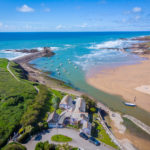Bude Harbour
Bude Harbour Office, Bude Visitor Centre, The Crescent, Bude, Cornwall, EX23 8LE
HARBOUR MASTER
Paul Vincent
CALL:
07816 077755
Welcome to Bude Harbour
Bude Harbour consists of a seaward area, known as Budehaven, and an Inner Harbour with a sea lock connecting them which gives access further upstream to the Bude Canal. Harbour Orders relevant to Bude date from 1819 to 1960.
There is a small area for drying moorings sheltered by a breakwater and the Inner Harbour containing the sea lock, the only hand operated one in the country, and basin. Visiting yachts will pass through the sea lock into the Inner Basin where alongside and overwintering berths are available.
Around thirty small boats use the tidal moorings in the harbour during the summer months, most are sport fishermen, but there is also some small-scale, semi-commercial, fishing for crab and lobster. There is a wharf on the Bude Canal about half a mile from the sea lock that links the canal to the tidal haven.
Swimmers and small leisure craft such as canoes and stand up paddle boards – please keep clear of the harbour entrance and channel (Barrel Rock) as boats may be entering at speed in a following sea and do not have the ability to turn to avoid you.
For the latest information on Bude Canal and Harbour please see the Cornwall Council Lets Talk Engagement Platform.
History
In the 18th century Bude had a small unprotected tidal harbour, the Bude Canal Company built a canal and improved the harbour. Its original purpose was to take small tub boats of mineral-rich sand from the beaches at Bude and carry them inland for agricultural use on fields.

A series of inclined planes carried the boats over 400 vertical feet (120 m) to Red Post, where the canal branched south along the upper Tamar Valley towards Launceston, east to Holsworthy and north to the Tamar Lakes that fed the canal.
The enterprise carried considerable volumes of sand and also coal from South Wales. The arrival of the railway at Holsworthy and the production of cheap manufactured fertiliser undermined the canal’s commercial purpose, and it was closed down and sold to the district municipal water company. However, the wharf area and harbour enjoyed longer success and coastal sailing ships carried grain across to Wales and coal back to Cornwall.
The canal was regenerated in 2009 which brought it back into a good state of repair and it is now used by people for leisure activities such as fishing, canoeing, walking and running.
The Breakwater was first constructed in 1819 to protect Bude Canal, it was then destroyed by a storm in 1838. The present structure dates from 1839-43, and was built by George Casebourne, engineer to the Bude Harbour & Canal Company. The low wall with its sloping seaward side stands only 4ft above the high-water mark of Spring tides.
photo gallery
Photo credits – Tim Martindale / Channel Images













